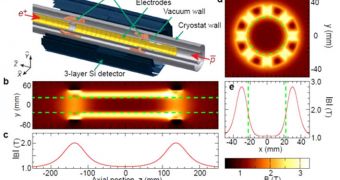Scientists announced the achievement of an important milestone in particle physics – the confinement of antimatter particles for prolonged periods of time. Experts were able to contain antihydrogen nuclei for no less than 1,000 seconds, which is the equivalent of 16.6 minutes.
The previous record was less than 172 milliseconds. In that research, experts were only able to isolate 38 antiatoms. Since then, researchers have wondered about how long an atom could be held for, before it finally destabilizes, and is destroyed.
The first antihydrogen atoms were trapped in 2010 at a massive particle accelerator near Geneva, at the Swiss-French border. The study was led by experts with the Large Hadron Collider (LHC) Antihydrogen Laser Physics Apparatus (ALPHA) experiment.
Officials with the European Organization for Nuclear Research (CERN), who manage the LHC, say that the same time was behind the new achievement as well. A few days ago, the group trapped no less than 309 antiatoms for more than 16 minutes.
This increases covers four orders of magnitude, say ALPHA investigators. With the increased storage capabilities, experts will nor find it easier to study some of the most interesting aspects of the interactions developing between normal, baryonic matter and antimatter.
One of the most interesting problems is whether gravity acts on antimatter in the same way it acts on regular matter. Simply put, experts are trying to determine if antihydrogen, once left untethered, will fall to the ground, or soar into the sky.
“Atoms made of a particle and an antiparticle are unstable, usually surviving less than a microsecond. Antihydrogen, made entirely of antiparticles, is believed to be stable, and it is this longevity that holds the promise of precision studies of matter-antimatter symmetry,” researchers say.
“We have recently demonstrated trapping of antihydrogen atoms by releasing them after a confinement time of 172 ms. A critical question for future studies is: how long can anti-atoms be trapped?” the study team goes on to say, quoted by Technology Review.
“Here we report the observation of antiatom confinement for 1000 s, extending our earlier results by nearly four orders of magnitude. Our calculations indicate that most of the trapped anti-atoms reach the ground state,” they add, in a paper published in the online journal arXiv.
The study was led by an international collaboration of researchers, which included scientists from Canada, the UK, Germany, Switzerland, Sweden, the United States, Israel and Japan, among others.

 14 DAY TRIAL //
14 DAY TRIAL //